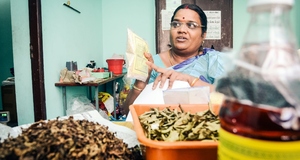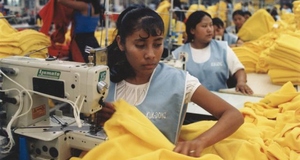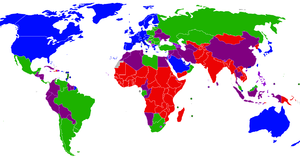Rethinking Microcredit in Bangladesh: Does Grameen Bank Serve the Neoliberal Agenda?
By
2016, Vol. 8 No. 09 | pg. 2/2 | « Grameen Bank, Microcredit and Social BusinessesNeoliberalism functions at the grassroots level through the microcredit operations of NGOs in Bangladesh such as Grameen Bank. The so called success of NGOs in loan recovery makes it lucrative for multinational and financial services corporations to invest in the poor, and local NGOs as well as the Bangladeshi government in turn provide security to these corporations for their investments (Faraizi, Rahman & McAllister, 2011, p. 114). This clearly shows the strong ties between neoliberalism and microcredit. NGOs in Bangladesh play an instrumental role in selling commodities to the poor. Multinational corporations use NGOs to enter local markets, to look for buyers to sell their products and export their revenues (Karim, 2011, pp. 201-202). As a result, rural people in Bangladesh receiving microcredit from NGOs such as Grameen Bank become consumers for the products of multinational corporations. Muhammad (2015) suggests that Grameen Bank accumulates enormous amounts of capital through its microfinance operations and participates in joint ventures with multinational corporations, thus becoming a corporate NGO. Consistent with neoliberal ideology, Muhammad Yunus (2007) points out the limited role of the government in society, “We don’t have to put everything on the shoulders of the government. Governments are limited; they cannot do everything, and we have responsibilities as citizens. Social business is one way we can address them” (p. 266). Yunus (2007) further claims that social businesses are “cause-driven rather than profit-driven” and do not compromise social objectives (p. 267). Although Grameen Bank’s socially responsible businesses may give the illusion of development on the surface, in reality multinational corporations use these social business partnerships to target poor communities and generate profits in the name of helping the poor. Therefore, instead of poverty reduction, Grameen Bank’s success should actually be attributed to its corporate expansion and establishment of a new kind of financial industry (Muhammad, 2015). Grameen Danone and Grameen Polli (Village) Phone are just two examples of social business partnerships actively promoted and popularized by Grameen Bank, among numerous other joint ventures with corporations, which target the poor only when it is profitable. It is important to note that these socially responsible businesses, established in the name of the poor and through the Grameen network, are actually separate legal entities not owned by Grameen Bank borrowers and therefore Grameen Bank borrowers do not receive any direct benefits from these businesses (Muhammad, 2009).Grameen Bank and Danone Corporation in France signed off on a partnership to produce a highly fortified yogurt called Shaktidoi, providing 30% of the nutritional requirements of a child in Bangladesh (Karim, 2011, p. 67). Grameen Bank and Danone Corporation benefited from Grameen Bank’s microlending operations in rural Bangladesh and created a consumer base for their product among Grameen Bank clients as the yogurt was sold in Grameen Bank centers where female borrowers gathered weekly to pay their loan installments (Karim, 2011, p. 67). Grameen Bank specifically targeted female borrowers who had some disposable cash on loan collection day and loan officers could even convince these female borrowers to buy the Grameen-owned product (Karim, 2011, p. 67). Socially responsible business ideas are really corporate deals that are presented to the public as new innovations to help the poor, when in fact their main objective is to maximize profits for corporations. However, the yogurt was overpriced and beyond the financial capacity of a poor family in rural Bangladesh. As many people in Bangladesh struggle to survive everyday, not having their basic needs met and even starving, this yogurt became a luxury product for them rather than a necessity. As this consumer base of poor female borrowers failed to generate profits and Grameen Danone failed to recover their costs, they abandoned their consumer base consisting mainly of poor women and turned their interests towards the urban middle class in Bangladesh with a higher selling price, which now makes up their new consumer base (Karim, 2011, p. 68). It is thus evident that socially responsible business ideas are really corporate deals that are presented to the public as new innovations to help the poor, when in fact their main objective is to maximize profits for corporations (Karim, 2011, p. 68). Grameen Polli Phone, a subsidiary of Grameenphone and jointly owned by Grameen Telecom and Norwegian telecommunications giant Telenor, is another example of a socially responsible business intended to maximize profits for Grameen Bank (Muhammad, 2015; Karim, 2011, p. 69). It encouraged female Grameen Bank borrowers to open up their own phone businesses in their villages by leasing them cell phones to deliver telecommunication services to rural areas of Bangladesh. The cell phones themselves were offered as a commodity form of microcredit on the condition that the money would be paid back in installments (“Peripheral Economy,” 2010). This was initially a very lucrative business idea as the phones were extremely expensive and poor borrowers could only afford the phones by taking out loans from Grameen Bank, thus maximizing Grameen Banks’s profits (Karim, 2011, p. 69). However, increased competition from other phone companies also operating in rural areas of Bangladesh caused a decline in profits and many women were forced to give up their cell phone businesses (Karim, 2011, p. 69). Female Grameen Bank borrowers who had to consume the entirety of their incomes due to need and who were not able to reinvest the money in another way could not make profits and thus suffered losses from their phone businesses, while Grameen Bank and associated corporations abandoned them to maximize their own profits. Despite the financial losses of poor rural women, Grameenphone subscribers increased as it turned its interests towards urban and middle class subscribers in Bangladesh, which led to substantial gains for the corporations involved (Karim, 2011, p. 69). Although Grameenphone initially relied on the microcredit operations of Grameen Bank and declared that its objective was to help the poor and alleviate poverty, it quickly turned to more profitable areas and sections of society and became the largest cell phone operator in Bangladesh, with 90% of subscribers being non-poor urban Bangladeshis (“Peripheral Economy,” 2010). Sentiments of commitment and responsibility commonly attributed to social businesses are used as embellishments to enhance the profitability of big corporations, but when profits are at stake, corporations easily abandon these principles and move on to their next profit-generating business plan. ConclusionI take a critical approach to the idea of microcredit delivering real and meaningful development to rural Bangladesh and argue that in the name of helping the poor, Grameen Bank promotes a Western neoliberal agenda and advances corporate capitalist interests through its microcredit operations. Due to Bangladesh’s reliance on Western aid, international organizations such as the World Bank and International Monetary Fund as well as powerful Western nations and multinational corporations easily exploit Bangladesh and its people with the help of local grassroots NGOs such as Grameen Bank. I find that neoliberalism and microcredit are inherently connected and that the Western conception of development helps facilitate the exploitation of the poor through microcredit. While Grameen Bank claims to empower poor women, it is evident that their microcredit operations largely serve to transform poor Bangladeshi women into prisoners of debt and their social business partnerships with multinational corporations are merely profit-making expeditions intended to exploit vulnerable women in rural Bangladesh. With profit-oriented ambitions neglecting borrower interests and needs, Grameen Bank and microcredit fail to positively impact the lives of rural Bangladeshis as well as deliver long-term sustainable development in Bangladesh. ReferencesChowdhury, F. (2010). Dowry, Women and Law in Bangladesh. International Journal of Law, Policy and the Family, 24(2),198–221. Cornwall, A., & Brock, K. (2005). What Do Buzzwords Do for Development Policy? A Critical Look at 'Participation', 'Empowerment' and 'Poverty Reduction' Third World Quarterly, 26(7), 1043-1060. Cowen, M., & Shenton, R. (1995). The Invention of Development. In J. Crush (Ed.), Power of Development (pp. 25-41). London: Routledge. Faraizi, A., Rahman, T., & McAllister, J. (2011). Microcredit and Women's Empowerment A case Study of Bangladesh. London: Routledge. Fernando, J. (1997). Nongovernmental Organizations, Micro-Credit, and Empowerment of Women. The Annals of the American Academy of Political and Social Science, 554, 150-177. Goetz, A., & Gupta, R. (1996). Who Takes the Credit? Gender, Power, and Control Over Loan Use in Rural Credit Programs in Bangladesh. World Development, 24(1), 45-63. Graeber, D. (2013). A Practical Utopian's Guide to the Coming Collapse. The Baffler, 1-10. Gramen Bank. (n.d.). Retrieved from http://www.grameen-info.org/. Harvey, D. (2007). Brief History of Neoliberalism. Oxford: Oxford University Press. Isserles, R. (2003). Microcredit: The Rhetoric of Empowerment, the Reality of "Development As Usual" Women's Studies Quarterly, 31(3/4), 38-57. Jasim Uddin, M. (2015). The Micro-politics of Microcredit Gender and Neoliberal Development in Bangladesh. London: Routledge. Kabeer, N. (2001). Conflicts Over Credit: Re-Evaluating the Empowerment Potential of Loans to Women in Rural Bangladesh. World Development, 29(1), 63-84. Karim, L. (2008). Demystifying Micro-Credit The Grameen Bank, NGOs and Neoliberalism in Bangladesh. Cultural Dynamics, 20(1), 5-29. Karim, L. (2011). Microfinance And Its Discontents Women in Debt in Bangladesh. Minneapolis: University of Minnesota Press. Khandker, S. (1998). Fighting Poverty with Microcredit Experience in Bangladesh. New York: Oxford University Press. Mosse, D. (2004). Is Good Policy Unimplementable? Reflections on the Ethnography of Aid Policy and Practice. Development and Change, 35(4), 639–671. Muhammad, A. (2009). Grameen and Microcredit : A Tale of Corporate Success. Economic and Political Weekly, XLIV(35), 35-42. Muhammad, A. (2015). Bangladesh—A Model of Neoliberalism The Case of Microfinance and NGOs. Monthly Review An Independent Socialist Magazine. Peripheral Economy, Global Capital and Movements in Bangladesh: An Interview with Anu Muhammad. (2010). Retrieved from http://radicalnotes.com/2010/12/28/peripheral-economy-global-capital-and-movements-in-bangladesh-an-interview-with-anu-muhammad/. Rahman, A. (1999).Women and Microcredit in Rural Bangladesh Anthropological Study of the Rhetoric and Realities of Grameen Bank Lending. Boulder: Westview Press. Shrestha, N. (1995). Becoming a Development Category. In J. Crush (Ed.), Power of Development (pp. 259-270). London: Routledge. The Bangladesh poor selling organs to pay debts. (2013). Retrieved from http://www.bbc.com/news/world-asia-24128096. Yunus, M. (2007). Banker to the Poor Micro-lending and the Battle Against World Poverty. New York: Public Affairs. Suggested Reading from Inquiries Journal
Inquiries Journal provides undergraduate and graduate students around the world a platform for the wide dissemination of academic work over a range of core disciplines. Representing the work of students from hundreds of institutions around the globe, Inquiries Journal's large database of academic articles is completely free. Learn more | Blog | Submit Latest in International Affairs |


















